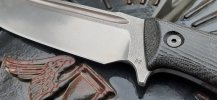Nathan the Machinist
KnifeMaker / Machinist / Evil Genius
Moderator
Knifemaker / Craftsman / Service Provider
- Joined
- Feb 13, 2007
- Messages
- 15,654
Hey Nathan wanted to ask about BTE of HDMC.
on Behemother BTE is .040" as far as I remember, what about HDMC?
thickness at ricasso is same on both Behemother and HDMC - .275" so BTE is same also or?
HDMC is indestructible knife as far as I know. I've seen you cutting bolts with it.
what about Behemother? will it perform same in same scenario or?
in terms of toughness, geometry plays huge role as far as I know, so BTE means a lot when "cutting bolts"
The HDMC is a more obtuse primary bevel geometry and thicker behind the edge than the Behemother. However both will cut a bolt. The Behemother is a high performance cutting tool the HDMC is an indestructible WMD

